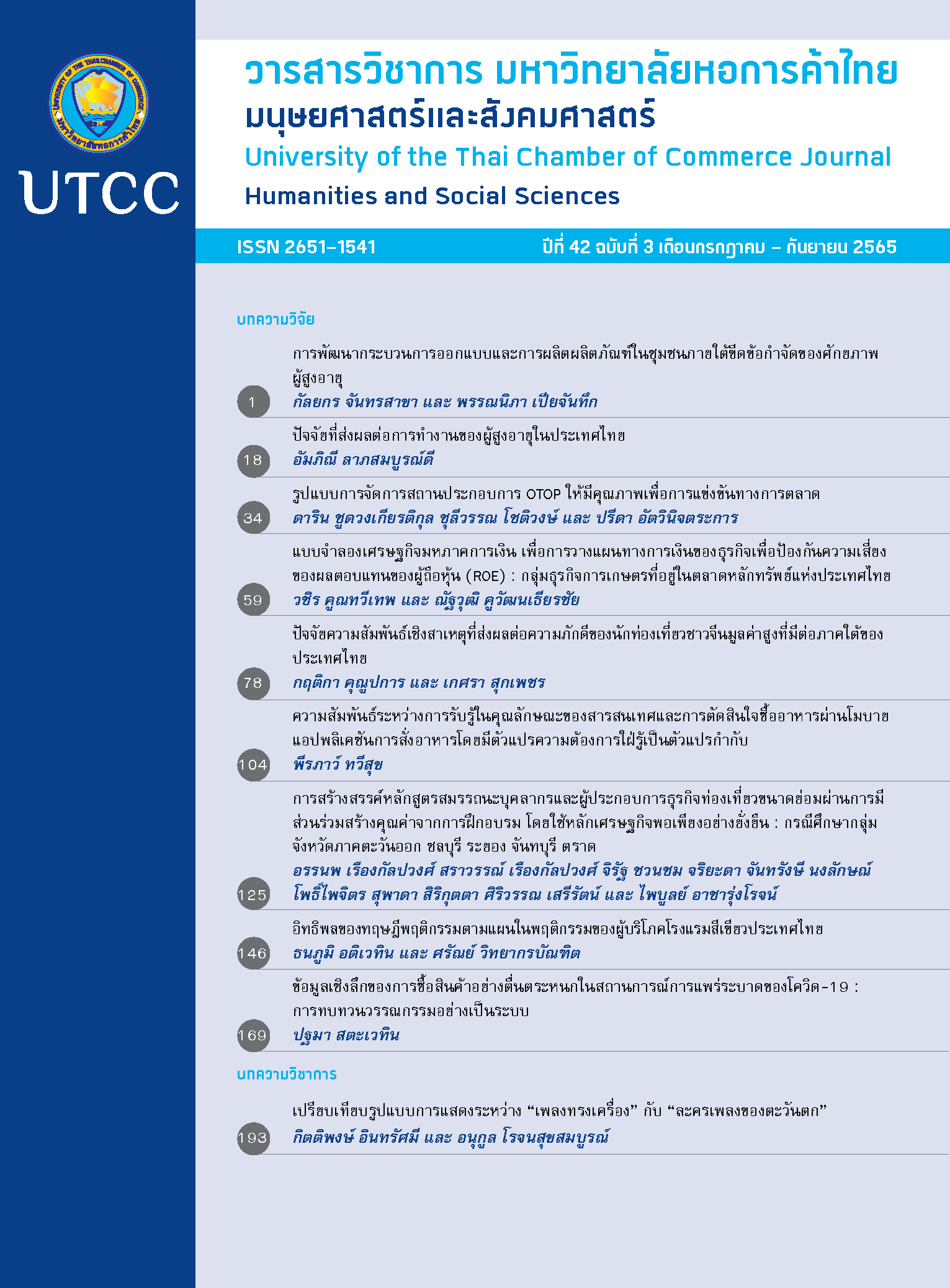Factors Affecting the Elderly Work in Thailand
Main Article Content
Abstract
The purpose of this article aims to present the situation of elderly work and analyze factors affecting the elderly’s work in Thailand, used data form Labor Force Survey 2020 Quarter 3: July-September 2020 and Household Socio-Economic Survey 2020, using the binary logistic regression. The results indicate that the participation rate of the elderly has declined, Older people’s jobs do not require skills. The probability for the elderly to work increased significantly with male, age, married, household debt, while age-squared, education, urban, civil servant medical benefit scheme and the elderly support ratio had a negative effect on the probability to work, the probability that the elderly do not work decreased significantly with age-squared education area. Therefore, Incentives for elderly female worker such as tax exemption, suitable legal protection for older worker, financial incentives for the elderly will keep the potential elderly still working, this will increase the number of older workers to drive the economy.
Article Details

This work is licensed under a Creative Commons Attribution-NonCommercial-NoDerivatives 4.0 International License.
ลิขสิทธิ์ของบทความ
ผลงานที่ได้รับการตีพิมพ์ถือเป็นลิขสิทธิ์ของมหาวิทยาลัยหอการค้าไทย ห้ามมิให้นำเนื้อหา ทัศนะ หรือข้อคิดเห็นใด ๆ ของผลงานไปทำซ้ำ ดัดแปลง หรือเผยแพร่ ไม่ว่าทั้งหมดหรือบางส่วนโดยไม่ได้รับอนุญาตเป็นลายลักษณ์อักษรจากมหาวิทยาลัยหอการค้าไทยก่อน
References
คมสัน สุริยะ. (2552). แบบจำลองโลจิต: ทฤษฎีและการประยุกต์ใช้ในการวิจัยทางเศรษฐศาสตร์. เชียงใหม่:มหาวิทยาลัยเชียงใหม่, คณะเศรษฐศาสตร์, ศูนย์การวิเคราะห์เชิงปริมาณ.
เฉลิมพล แจ่มจันทร์, และ สุภรต์ จรัสสิทธิ์. (2564). สถานการณ์และแนวโน้มสภาพการทำงานของผู้สูงอายุไทย:การวิเคราะห์จากข้อมูลการสำรวจระดับประเทศ. สืบค้นจาก https://ipsr.mahidol.ac.th/ipsrbeta/FileUpload/PDF/Report-File-630.pdf
นิภาพรรณ เจนสันติกุล. (2564). สภาพปัญหาและรูปแบบการจ้างแรงงานสูงอายุของสถานประกอบการเอกชนในประเทศไทย. วารสารวิชาการวิทยาลัยบริหารศาสตร์, 4(1), 50-66.
พิสุทธิ์ กุลธนวิทย์, และนงนุช สุนทรชวกานต์. (2562). การตัดสินใจทำงานและจ้างงานต่อหลังเกษียณอายุ:บทสำรวจภาคสนาม. BU Academic Review, 18(1), 148-164. สืบค้นจาก https://so01.tci-thaijo.org/index.php/buacademicreview/article/view/165585
สำนักงานสถิติแห่งชาติ. (2561). รายงานการสำรวจประชากรสูงอายุในประเทศไทย พ.ศ. 2560. กรุงเทพฯ: ผู้แต่ง.
สำนักงานสถิติแห่งชาติ. (2563). การสำรวจภาวะการทำงานของประชากรทั่วราชอาณาจักร ไตรมาสที่ 3:กรกฎาคม-กันยายน 2563. กรุงเทพฯ: ผู้แต่ง.
สำนักงานหลักประกันสุขภาพแห่งชาติ. (2555). ระบบหลักประกันสุขภาพไทย. กรุงเทพฯ: ผู้แต่ง.
Becker, G. S. (2007). Health as human capital: Synthesis and extensions. Oxford Economic Papers,59(3), 379-410. https://doi.org/10.1093/oep/gpm020
Borjas, G. J. (2013). Labor economics (6th ed.). New York, NY: McGraw-Hill/Irwin.
Britton, J., & French, E. (2020). Health and employment amongst older workers. Fiscal Studies,41(1), 221-250. https://doi.org/10.1111/1475-5890.12213
Campbell, J. C., Ikegami, N., & Gibson, M. J. (2010). Lessons from public long-term care insurance in Germany and Japan. Health Affairs, 29(1), 87-95. doi:10.1377/hlthaff.2009.0548
Chen, J., & Chuang, C.-H. (2012). Phased retirement for older workers in Taiwan. Journal of Family and Economic Issues, 33, 328-337. https://doi.org/10.1007/s10834-012-9285-4
Coile, C., & Gruber, J. (2007). Future social security entitlements and the retirement decision.The Review of Economics and Statistics, 89(2), 234-246. https://doi.org/10.1162/rest.89.2.234
Coile, C. C. (2015). Economic determinants of workers’ retirement decisions. Journal of Economic Surveys, 29(4), 830-853. https://doi.org/10.1111/joes.12115
Cremer, H., Lozachmeur, J.-M., & Pestieau, P. (2008). Social security and retirement Decision: A positive and normative approach. Journal of Economic Surveys, 22(2), 213-233.https://doi.org/10.1111/j.1467-6419.2007.00528.x
Favreault, M., Ratcliffe, C., & Toder, E. (1999). Labor force participation of older workers: Prospective changes and potential policy responses. National Tax Journal, 52(3), 483-503.
Figueira, D. A. M., Haddad, M. d. C. L., Gvozd, R., & Pissinati, P. d. S. C. (2017). Retirement decisionmaking influenced by family and work relationships. Revista Brasileira de Geriatria e Gerontologia, 20(2), 206-213. https://doi.org/10.1590/1981-22562017020.160127
Greene, W. H. (2008). Econometric analysis (6th ed.). Upper Saddle River, NJ: Pearson/Prentice Hall.
Haider, S. J., & Loughran, D. (2001). Elderly labor supply: Work or play? Retrieved from https://ssrn.com/abstract=285981
Holtmann, A. G., Ullmann, S. G., Fronstin, P., & Longino, C. F. (1994). The early retirement plansof women and men: An empirical application. Applied Economics, 26(6), 591-601. https://doi.org/10.1080/00036849400000029
Horioka, C. Y., Morgan, P. J., Niimi, Y., & Wan, G. (2018). Aging in Asia: Introduction to symposium.Review of Development Economics, 22(3), 879-884. https://doi.org/10.1111/rode.12545
Kallestrup-Lamb, M., Kock, A. B., & Kristensen, J. T. (2016). Lassoing the determinants of retirement. Econometric Reviews, 35(8-10), 1522-1561. doi: 10.1080/07474938.2015.1092803
Ogawa, N., Mansor, N., Lee, S.-H., Abrigo, M. R. M., & Aris, T. (2021). Population aging and the three demographic dividends in Asia. Asian Development Review, 38(1), 32-67. https://doi.org/10.1162/adev_a_00157
Polanec, S., Ahcan, A., & Verbic, M. (2013). Retirement decisions in transition: Microeconometric evidence from Slovenia. Post-Communist Economies, 25(1), 99-118. https://doi.org/10.1080/14631377.2013.756703
Poplawski-Ribeiro, M. (2020). Labour force ageing and productivity growth. Applied Economics Letters, 27(6), 498-502. https://doi.org/10.1080/13504851.2019.1637509
Roy, S. B. (2018). Effect of health on retirement of older Americans: A competing risks study.Journal of Labor Research, 39(1), 56-98. https://doi.org/10.1007/s12122-017-9255-6
Shimizutani, S. (2011). A new anatomy of the retirement process in Japan. Japan and the World Economy, 23(3), 141-152. https://doi.org/10.1016/j.japwor.2011.07.002
Stock, J., & Wise, D. (1990). Pensions, the option value of work, and retirement. Econometrica,58(5), 1151-1180.
United Nations. (2017). World population prospects: The 2017 revision, key findings and advance tables. Retrieved from https://population.un.org/wpp/publications/files/wpp2017_keyfindings.pdf


